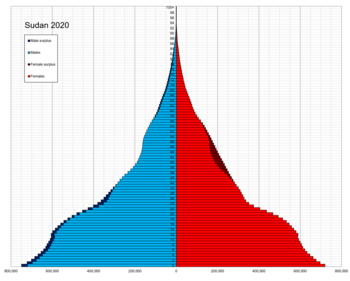
Back سودانيون Arabic Население на Судан Bulgarian Liste der Völker im Sudan German Demografía de Sudán Spanish Démographie du Soudan French 수단의 인구 Korean Sudano demografija Lithuanian Демографија на Судан Macedonian Demografi Sudan Malay Demografia do Sudão Portuguese
| Demographics of Sudan | |
|---|---|
 Population pyramid of Sudan in 2020 | |
| Population | 50,467,278 (2024 est.)[1] |
| Growth rate | 2.55% (2022 est.) |
| Birth rate | 33.47 births/1,000 population (2022 est.) |
| Death rate | 6.3 deaths/1,000 population (2022 est.) |
| Life expectancy | 67.12 years |
| Fertility rate | 4.6 children born/woman (2022 est.) |
| Infant mortality rate | 42.27 deaths/1,000 live births |
| Net migration rate | -1.67 migrant(s)/1,000 population (2022 est.) |
| Age structure | |
| 0–14 years | 42.01% |
| 65 and over | 3.03% |
| Nationality | |
| Nationality | Sudanese |
| Major ethnic | Sudanese Arabs (70.0%) |
| Minor ethnic | |
| Language | |
| Official | Arabic and English |
The demographics of Sudan include the Sudanese people (Arabic: سودانيون) and their characteristics, Sudan, including population density, ethnicity, education level, health, economic status, religious affiliations, and other aspects of the population.

In Sudan's 1993 census, the population was calculated at 30 million. No comprehensive census has been carried out since that time due to the Second Sudanese Civil War. Estimates of Sudan, including the population of South Sudan, ranged from 37 million (United Nations) to 45 million (CIA). Since the secession of South Sudan in July 2011, the current population of Sudan is estimated to be about 46 million.[2][3] The population of metropolitan Khartoum (including Khartoum, Omdurman, and Khartoum North) is growing rapidly and ranges from six to seven million, including around two million displaced persons from the southern war zone, as well as western and eastern drought-affected areas.
- ^ "Sudan". The World Factbook (2025 ed.). Central Intelligence Agency. Retrieved 24 September 2022. (Archived 2022 edition.)
- ^ "World Population Prospects 2022". United Nations Department of Economic and Social Affairs, Population Division. Retrieved July 17, 2022.
- ^ "World Population Prospects 2022: Demographic indicators by region, subregion and country, annually for 1950-2100" (XSLX) ("Total Population, as of 1 July (thousands)"). United Nations Department of Economic and Social Affairs, Population Division. Retrieved July 17, 2022.